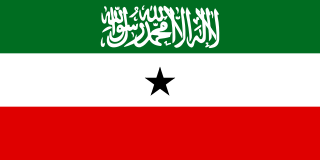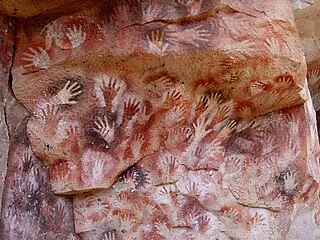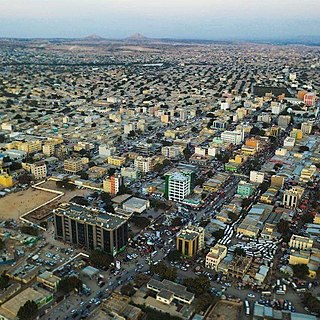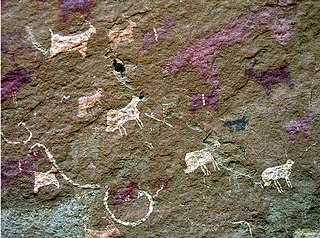
Somaliland, officially the Republic of Somaliland, is an unrecognised country in the Horn of Africa. It is located in the southern coast of the Gulf of Aden and bordered by Djibouti to the northwest, Ethiopia to the south and west, and Somalia to the east. Its claimed territory has an area of 176,120 square kilometres (68,000 sq mi), with approximately 6.2 million people as of 2024. The capital and largest city is Hargeisa.

In archaeology, cave paintings are a type of parietal art, found on the wall or ceilings of caves. The term usually implies prehistoric origin. These paintings were often created by Homo sapiens, but also Denisovans and Neanderthals; other species in the same Homo genus. Discussion around prehistoric art is important in understanding the history of the Homo sapiens species and how Homo sapiens have come to have unique abstract thoughts. Some point to these prehistoric paintings as possible examples of creativity, spirituality, and sentimental thinking in prehistoric humans.

Sanag is an administrative region (gobol) in north eastern Somaliland. Sanaag has a long coastline facing the Gulf of Aden to the north, and is bordered by the region of Sahil to the west, Sool to the south and Somalia to the east. The region is disputed by the self-declared Republic of Somaliland and Puntland, a Federal Member State of Somalia. Its capital city is Erigavo. Sanaag is the largest region of Somaliland, accounting for 35% of Somaliland's total land area.

Marodi Jeh is an administrative region (gobol) in western Somaliland. It is the most populous region of the country. It is bordered by Awdal to the west, Sahil to the north, Togdheer to the east and Ethiopia to the south. Marodi Jeh was created by splitting the previously existing region (gobolka). In 2007 the region of Woqooyi Galbeed was renamed to Maroodi Jeex.

Hargeisa is the capital and largest city of the Republic of Somaliland, a de facto sovereign state in the Horn of Africa, still considered internationally to be part of Somalia. It is also the regional capital of the Maroodi Jeex region of Somaliland.

The history of Somaliland, a country in the eastern Horn of Africa bordered by the Gulf of Aden, and the East African land mass, begins with human habitation tens of thousands of years ago. It includes the civilizations of Punt, the Ottomans, and colonial influences from Europe and the Middle East.

The economy of Somaliland largely relies on primary production and agriculture, where livestock is the main export of the country, which it ships to neighbouring Djibouti and Ethiopia, as well as to Gulf states, such as UAE, Saudi Arabia and Oman. Somaliland has a GDP per capita of $1361 and a gross domestic product GDP of $7,583,000,000 as of 2024, most of which it receives in remittances from Somalis working abroad. The COVID-19 pandemic has restricted Somaliland's trade flows with decreased demand in the agriculture sector, a significant source of tax revenue.

Laas Geel, also spelled Laas Gaal, are cave formations on the rural outskirts of Hargeisa, Somaliland, situated in the Maroodi Jeex region of the country. They contain some of the earliest known cave paintings of domesticated African aurochs in the Horn of Africa. Laas Geel's rock art is estimated to date to circa 3,500-2,500 BCE.
Aw-Barkhadle is a town located near Hargeisa in modern-day Somaliland. It was part of the Muslim empires in the Horn of Africa during the middle ages and served as the capital of the Adal Sultanate. It was also the burial place for many of the local leaders including the rulers of the Walashma dynasty that governed the Ifat and Adal Sultanate and kingdoms. Prior to that, it was a very important pre-Islamic center. The town is wholly dominated by the Eidagale reer Cabdi ciise and Habr Yunis Isaxaaq carre. Both belong to the Garhajis clan.
El Afweyn is a town in the Sanaag region of Somaliland.

Heis is a historic coastal town located in the Sanaag region of Somaliland. The town was important for trade and communication with the Somali interior and was used to export frankincense to Arabia.

El Ayo, also known as El Ayum, is a coastal town in the eastern Sanaag region of Somalia.
Tourism in Somaliland is regulated by Somaliland's Ministry of Tourism.

Somali nationalism is a nationalist ideology advocating for the unification of all Somali people who share a common ethnicity, language, and culture, under a single banner. Its earliest manifestations has its roots in the Middle Ages with the Adal Sultanate and the Ajuran Sultanate whilst in the contemporary era its often traced back to the “Mad Mullah”, as he was known by the British Empire during the Scramble for Africa. The Somali Youth League, a political organisation founded in 1943 was one of the most influential political parties in Somalia prior to the country’s unification and independence. The Somali guerrilla militia Al-Shabab is noteworthy for incorporating Somali nationalism into its Islamist ideology.
Yusuf bin Ahmad al-Kawneyn, popularly known as Aw Barkhadle or Yusuf Al Kownayn, was an Islamic scholar and traveler based in Zeila, Somalia. According to Dr. Enrico Cerulli, Yusuf Al Kawneyn is referenced in the Harar manuscripts.

Sada Mire is a Swedish-Somali archaeologist, art historian and presenter from the Arap clan, who is currently a professor of Heritage Studies at University College London. She is a public intellectual and heritage activist who has argued that cultural heritage is a basic human need in her 2014 TEDxEuston talk. In 2017, Hay Festival of Literature and the Arts selected Mire as one of their 30 international thinkers and writers. She became the Director of Antiquities of Somaliland in 2007. Raised in the Somali capital of Mogadishu, Mire fled the country at the start of the civil war at the age of 15. She then traveled to Sweden seeking asylum. She has since returned to the Horn of Africa as an archaeologist.

Dhambalin is an archaeological site in the central Sahil province of Somaliland. The sandstone rock shelter contains rock art depicting various animals such as horned cattle and goats, as well as giraffes, an animal no longer found in the country. The site also features the earliest known pictures of sheep in Somaliland. Discovered in autumn 2007, residents of Beenyo Dhaadheer reported the rock art to the Somali archaeologist Sada Mire, Director of the Department of Archaeology within the Ministry of Tourism and Culture of Somaliland.

Karinhegane is an archaeological site in the eastern Sanaag region of Puntland. It contains some unique polychrome rock art.

Gaanlibah or Ga'an Libah English : The lion's paw ) is a mountain range, archaeological site, and national park located in the Maroodi Jeex region of Somaliland.

Dhaymoole is an archaeological site in the Sahil province of Somaliland. The site is a cave that contains a collection of ancient rock drawings showing a variety of animals as well as some unidentified symbols. These drawings were created during the third millennium BC.





















